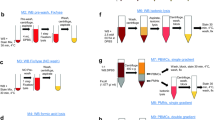Summary
The aim of this study was to establish a standard flow cytometric method to measure the phagocytic function of and intracellular hydrogen peroxide (H2O2) production by rat leukocytes. Thirty-six adult, male Sprague-Dawley rats were included in this study. Whole-blood specimens from the inferior vena cava were collected in a heparinized tube and ethylenediaminetetraacetic acid (EDTA) anticoagulated tube. The phagocytic function of and intracellular H2O2 generation by leukocytes were measured with FACS Vantage™ flow cytometer (Becton Dickinson, San Jose, CA), using fluorescent microspheres and dihydrorhodamine-123 as probes, respectively. Several conditions were optimized in this study, including anticoagulants (heparin and EDTA), fluorescent probes (0.75- and 1.72-μm-diameter microspheres), incubation time, and concentration of the chemicals used in the experiment. Neutrophils, monocytes, and lymphocytes could be clearly defined and separated in whole blood by flow cytometry and tested for phagocytosis and intracellular H2O2 generation without the need for further purification and handling of the cells. Intracellular H2O2 production by and phagocytic function of neutrophils and monocytes were inhibited in EDTA-anticoagulated blood compared with heparin-anticoagulated blood (P<0.01). Neutrophils showed similar phagocytic function to 0.75- and 1.72-μm microspheres, but monocytes showed weak phagocytic activity to 1.72-μm beads compared with 0.75-μm beads (P<0.01). In conclusion, a flow cytometric method to measure the phagocytic function of and intracellular H2O2 production by rat leukocytes has been developed. Quantitative flow cytometric analysis of rat leukocyte function is convenient and feasible and provides a reliable and rapid assay to assess phagocytosis and intracellular H2O2 production by rat neutrophils and monocytes.
Similar content being viewed by others
References
Antal, P.; Sipka, S.; Suranyi, P., et al. Flow cytometric assay of phagocytic activity of human neutrophils and monocytes in whole blood by neutral red uptake. Ann. Hematol. 70:259–265; 1995.
Bussolati, B.; Mariano, F.; Cignetti, A., et al. Platelet-activating factor synthesized by Il-12-stimulated polymorphonuclear neutrophils and NK cells mediates chemotaxis. J. Immunol. 161:1493–1500; 1998.
Emmendorffer, A.; Hecht, M.; Lohmann-Matthes, M. L.; Roesler, J. A fast and easy method to determine the production of reactive oxygen intermediates by human and murine phagocytes using dihydrorhodamine 123. J. Immunol. Methods 131:269–275; 1990.
Emmendorffer, A.; Nakamura, M.; Rothe, G., et al. Evaluation of flow cytometric methods for diagnosis of chronic granulomatous disease variants under routine laboratory conditions. Cytometry 18:147–155; 1994.
Hasui, M.; Hirabayashi, Y.; Kobayashi, Y. Simultaneous measurement by flow cytometry of phagocytosis and hydrogen peroxide production of neutrophils in whole blood. J. Immunol. Methods 117: 53–58; 1989.
Henderson, L. M.; Chappell, J. B. Dihydrorhodamine 123: a fluorescent probe for superoxide generation?. Eur. J. Biochem. 217:973–980; 1993.
Kinsey, B. M.; Kassis, A. I.; Fayad, F., et al. Synthesis and biological studies of iodinated (127/125I) derivatives of rhodamine 123. J. Med. Chem. 30:1757–1761; 1987.
Model, M. A.; KuKuruga, M. A.; Todd, R. F. A sensitive flow cytometric method for measuring the oxidative burst. J. Immunol. Methods 202: 105–111; 1997.
Prince, H. E.; Lape-Nixon, M. influence of specimen age and anticoagulant on flow cytometric evaluation of granulocyte oxidative burst generation. J. Immunol. Methods 188:129–138; 1995.
Rabesandratana, H.; Fournier, A. M.; Chateau, M. T., et al. Increased oxidative metabolism in PMA-activated lymphocytes: a flow cytometric study. Int. J. Immunopharmacol. 14:895–902; 1992.
Richardson, M. P.; Ayliffe, M. J.; Helbert, M.; Davies, E. G. A simple flow cytometry assay using dihydrorhodamine for the measurement of the neutrophil respiratory burst in whole blood: comparison with the quantitative nitrobluetetrazolium test. J. Immunol. Methods 219:187–193; 1998.
Robinson, J. P.; Bruner, L. H.; Bassoe, C. F., et al. Measurement of intracellular fluorescence of human monocytes relative to oxidative metabolism. J. Leukoc. Biol. 43:304–310; 1988.
Rothe, G.; Emmendorffer, A.; Oser, A., et al. Flow cytometric measurement of the respiratory burst activity of phagocytes using dihydrorhodamine 123. J. Immunol. Methods 138:133–135; 1991.
Rothe, G.; Oser, A.; Valet, G. Dihydrorhodamine 123: a new flow cytometric indicator for respiratory burst activity in neutrophil granulocytes. Naturwissenschaften 75:354–355; 1988.
Sakaguchi, N.; Inoue, M.; Ogihara, Y. Reactive oxygen species and intracellular Ca2+, common signals for apoptosis induced by gallic acid. Biochem. Pharmacol. 55:1973–1981; 1998.
Santos, J. L.; Montes, M. J.; Gutierrez, F.; Ruiz, C. Evaluation of phagocytic capacity with a modified flow cytometry technique. Immunol. Lett. 45:1–4; 1995.
Van Eeden, S. F.; Klut, M. E.; Walker, B. A.; Hogg, J. C. The use of flow cytometry to measure neutrophil function. J. Immunol. Methods 232:23–43; 1999.
van Pelt, L. J.; van Zwieten, R.; Weening, R. S., et al. Limitations on the use of dihydrorhodamine 123 for flow cytometric analysis of the neutrophil respiratory burst. J. Immunol. Methods 191:187–196; 1996.
Volk, T.; Gerst, J.; Faust-Belbe, G., et al. Monocyte stimulation by reactive oxygen species: role of superoxide and intracellular Ca2+. Inflamm. Res. 48:544–549; 1999.
Vowells, S. J.; Sekhsaria, S.; Malech, H. L., et al. Flow cytometric analysis of the granulocyte respiratory burst: a comparison study of fluorescent probes. J. Immunol. Methods 178:89–97; 1995.
Wheeler, M. D.; Thurman, R. G. Production of superoxide and TNF-alpha from alveolar macrophages is blunted by glycine. Am. J. Physiol. 277:L952-L959; 1999.
Author information
Authors and Affiliations
Corresponding author
Rights and permissions
About this article
Cite this article
Li, W., Sydney Chung, S.C. Flow cytometric evaluation of leukocyte function in rat whole blood. In Vitro Cell.Dev.Biol.-Animal 39, 413–419 (2003). https://doi.org/10.1290/1543-706X(2003)039<0413:FCEOLF>2.0.CO;2
Received:
Accepted:
Issue Date:
DOI: https://doi.org/10.1290/1543-706X(2003)039<0413:FCEOLF>2.0.CO;2




